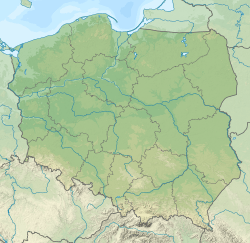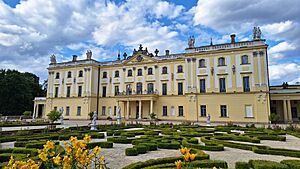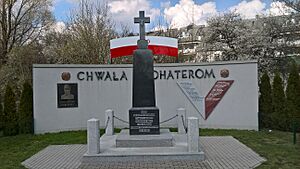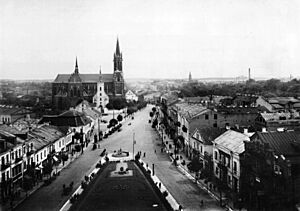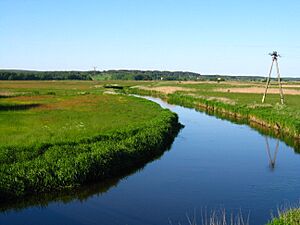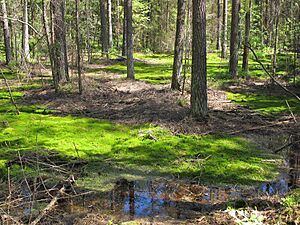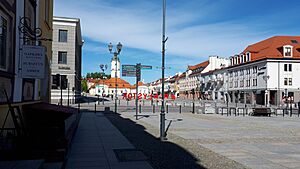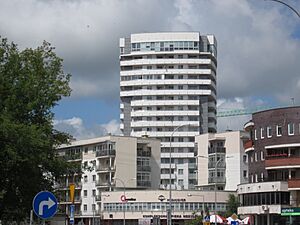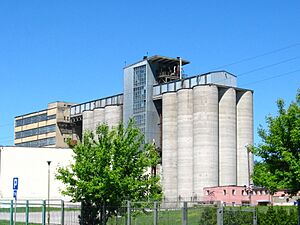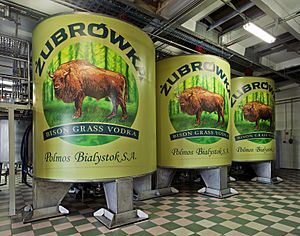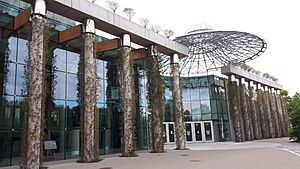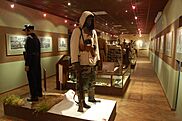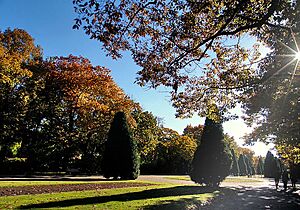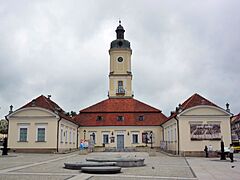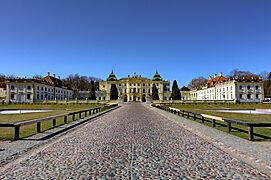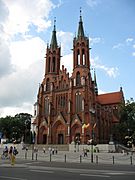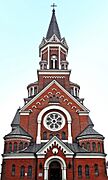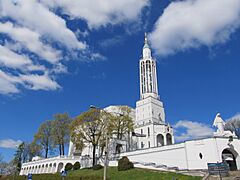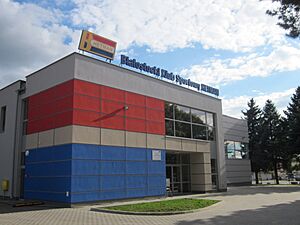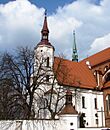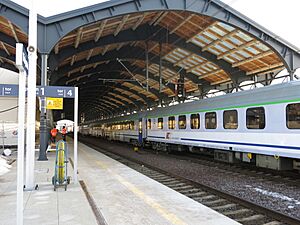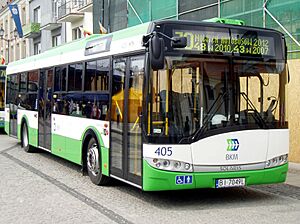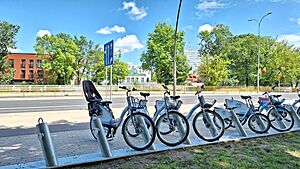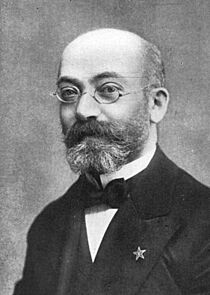Białystok facts for kids
Quick facts for kids
Białystok
|
|||||
|---|---|---|---|---|---|
|
|||||
|
|||||
| Country | |||||
| Voivodeship | |||||
| County | city county | ||||
| Established | 1437 | ||||
| City rights | 1692 | ||||
| Districts |
29: Osiedla
Centrum
Białostoczek Sienkiewicza Bojary Piaski Przydworcowe Młodych Antoniuk Jaroszówka Wygoda Piasta I Piasta II Skorupy Mickiewicza Dojlidy Bema Kawaleryjskie Nowe Miasto Zielone Wzgórza Starosielce Słoneczny Stok Leśna Dolina Wysoki Stoczek Dziesięciny I Dziesięciny II Bacieczki Zawady Dojlidy Górne Bagnówka |
||||
| Area | |||||
| • Total | 102.13 km2 (39.43 sq mi) | ||||
| Highest elevation | 175 m (574 ft) | ||||
| Lowest elevation | 118 m (387 ft) | ||||
| Population
(31 December 2021)
|
|||||
| • Total | 295,683 |
||||
| • Density | 2,902/km2 (7,520/sq mi) | ||||
| Time zone | UTC+1 (CET) | ||||
| • Summer (DST) | UTC+2 (CEST) | ||||
| Postal code |
15-001 to 15-999
|
||||
| Area code(s) | +48 85 | ||||
| Car plates | BI | ||||
| Highways | |||||
Białystok is a large city in northeastern Poland. It is the capital of the Podlaskie Voivodeship region. Białystok is the tenth-largest city in Poland by population. It is also the second most crowded city in terms of population density.
The city sits on the Biała River, about 200 kilometers (124 miles) northeast of Warsaw. Białystok has always been a place that attracts people from different parts of Poland and other countries. This is partly because it is close to the border with Belarus, which is also the eastern border of the European Union.
Białystok has a climate with warm summers and long, cold winters. Forests are a big part of the city's look. About 18% of the city's area is covered by forests. This makes it the fifth most forested city in Poland.
People first settled here in the 14th century. The town grew and became a city in 1692. Białystok has been a key center for learning, culture, and art in the Podlachia region. It is also the most important economic hub in northeastern Poland. The city was once famous for its light industry, which helped its population grow a lot. Today, Białystok is becoming a modern, mid-sized city.
Contents
- What's in a Name? The Meaning of Białystok
- A Journey Through Time: Białystok's History
- Exploring Białystok's Geography
- Białystok's Districts: How the City is Organized
- Metropolitan Białystok: The Wider Area
- Who Lives in Białystok? Demographics
- Białystok's Economy: How the City Makes Money
- Public Services
- Culture and Tourism in Białystok
- Sports in Białystok
- Media in Białystok
- Religion in Białystok
- Getting Around: Transport in Białystok
- Learning in Białystok: Education
- Famous People from Białystok
- See also
What's in a Name? The Meaning of Białystok
The name "Białystok" comes from the river that flows through the city. In old Polish, biały stok meant "white river" or "white stream." Biały means white, and stok meant a stream or a river that flows down a slope. So, the Biała River, which is quite small today, gave the city its name.
Over time, because borders and people changed, the city was known by different names in other languages. These names included Byelastok in Belarusian, Byalistok in Yiddish, and Balstogė in Lithuanian.
A Journey Through Time: Białystok's History
How Did Białystok Begin?
Archaeological finds show that people first lived in the Białystok area during the Stone Age. Ancient tombs can be found in the Dojlidy district. In the early Iron Age, people built burial mounds called kurgans for their chiefs.
Białystok has been a meeting point for different cultures for centuries. Trade routes connecting the Baltic Sea to the Black Sea helped settlements grow. These early settlements mixed cultures from Yotvingia, Ruthenia, and Poland.
Records show that around 1437, a man named Jakub Tabutowicz received land along the Biała River. This was the start of Białystok as a settlement. For 132 years, Białystok was part of Lithuania. In 1569, it became part of Poland.
From 1547, the Wiesiołowski family owned the settlement. They started the first school. They also built the first brick church and a castle between 1617 and 1826. The castle was later expanded. After the Wiesiołowski family, Białystok was managed by the Polish Crown.
A City of Nobles and Grand Palaces
In 1661, Białystok was given to Stefan Czarniecki for his bravery in a war. Later, it became part of the Branicki family through marriage. In 1692, Stefan Mikołaj Branicki got city rights for Białystok from King John III Sobieski. He built the impressive Branicki Palace on the old castle's foundations.
In the 1700s, Jan Klemens Branicki made the palace even grander. It became a magnificent home for a powerful noble. Polish kings and poets often visited it. In 1745, Poland's first military technical school opened in Białystok. In 1748, one of Poland's oldest theaters, the Komedialnia, was founded. New schools, including a ballet school, were also started. In 1749, King Augustus III of Poland made the city bigger. In 1770, a midwifery school was founded.
At the end of the 1700s, Poland was divided by its neighbors. Białystok became part of Prussia in 1795. It became the capital of the New East Prussia province. In 1807, after Napoleon Bonaparte's victory, Białystok was given to the Russian Empire. It became the center of the Belostok Oblast. The growth of schools in Białystok stopped because of these changes.
Growing with Industry
Białystok became a city later than others in its region. However, by the late 1800s, it had grown much larger than nearby cities. This fast growth was due to two main reasons. First, a customs border was created between the Russian Empire and the Kingdom of Poland. Second, the Saint Petersburg–Warsaw Railway opened in 1862. This railway connected Białystok to major cities like Warsaw and Saint Petersburg.
These good transport links helped Białystok's factories grow quickly. In the second half of the 19th century, Białystok became a major center for the textile industry. It was the largest textile hub in partitioned Poland after Łódź. People called Białystok the "Manchester of the North." After Polish uprisings failed, Russian rule became stricter. The use of Polish in public places was banned after 1870. In 1912, a Russian prison was built. It was also used to send Poles to Siberia.
By the end of the 1800s, many Jewish people lived in Białystok due to Russian rules. In 1897, about 63% of the city's 66,000 people were Jewish. This history is remembered on the Jewish Heritage Trail in Białystok. In 1906, a sad event called the Białystok pogrom happened. Many Jewish people were killed or hurt.
During World War I, Germany controlled Białystok. After the war, in 1919, the city became part of the new, independent Second Polish Republic. It became the capital of the Białystok Voivodeship. Białystok gained its freedom on February 19, 1919. This was three months after the rest of Poland, as German troops took longer to leave. During the Polish–Soviet War (1919–1920), the city was briefly held by the Soviet army. However, it returned to Polish control after the Battle of Białystok.
After the wars, Polish education and the textile industry in Białystok were rebuilt. A public library and sports clubs, like Jagiellonia Białystok, were started. In the 1930s, a drama theater was built.
Białystok During World War II
When World War II began, Poland was invaded by Nazi Germany and the Soviet Union. Białystok was first briefly occupied by Germany. German troops entered the city in September 1939. Then, the Germans handed the city over to the Soviet Union. This was part of the Molotov–Ribbentrop Pact. Under Soviet rule, Białystok became part of the Byelorussian SSR. Many Polish people were sent far away into the USSR. The pre-war mayor, Seweryn Nowakowski, was arrested and his fate is unknown. The Soviet secret police took over the local prison.
The Polish resistance was active in Białystok. Ryszard Kaczorowski, who later became President of Poland in exile, was part of this resistance. He was arrested by the Soviets in 1940 and sent to a forced labor camp. He was released in 1942 and joined the Polish army.
In 1941, Germany invaded the Soviet Union. Białystok was taken by the German Army on June 27, 1941. It became the capital of a German-controlled region until 1944. The Great Synagogue was burned down by Germans on June 27, 1941. Around 2,000 Jewish people were inside. The Nazis treated non-German people very harshly. They ran a prison and a forced labor camp for Jewish men. From 1943, Poles, including teenage boys, were sent from the local prison to the Stutthof concentration camp.
The 56,000 Jewish residents of Białystok were forced into a ghetto. On August 15, 1943, the Białystok Ghetto Uprising began. Several hundred Jewish people fought against the German troops. The Germans were trying to clear the ghetto and send people to the Treblinka extermination camp. Sadly, the ghetto was destroyed. Most of its remaining 40,000 people were killed by the Nazis, mainly at Treblinka.
The Soviet army took control of the city on July 27, 1944. They arrested many Polish resistance members. On September 20, 1944, Białystok was given back to Poland. However, a Soviet-backed communist government was put in place. This government stayed until the 1980s. The Soviets continued to persecute Polish resistance members. From November 1944 to January 1945, nearly 5,000 Poles were sent from the local prison to the Soviet Union. Later, the communists held political prisoners there. They also buried executed Polish resistance members at the prison until 1956.
Białystok After the War
After World War II, Białystok became the capital of the Białystok Voivodeship in the People's Republic of Poland. After changes in 1975, it remained the capital of a smaller Białystok Voivodeship. Since 1999, it has been the capital of the Podlaskie Voivodeship in the Republic of Poland.
Exploring Białystok's Geography
Białystok is located in the Białystok Uplands, which are part of the Podlaskie Plain. This area is known as the Green Lungs of Poland. The city is about 197 kilometers (122 miles) northeast of Warsaw. It is the largest Polish city close to Belarus and Lithuania. The Biała River, a branch of the Supraśl River, flows through the city.
The Białystok Upland has varied landscapes. You can find high hills and mounds over 200 meters (656 feet) above sea level. Large flat areas, formed by melting glaciers, are covered by forests.
The highest point in the city is 175 meters (574 feet) high in the Pietrasze Forest. The lowest point is 118 meters (387 feet) high in the Biała River valley. The city's landscape also has clear dips in the ground, where the Biała, Horodnianka, and Czaplinianka rivers flow.
Forests are a very important part of Białystok. They cover about 1,846 hectares (4,562 acres), which is 18% of the city's area. This makes Białystok the fifth most forested city in Poland.
There are 9 parks in the city. Five of these are historic parks, covering about 59 hectares (146 acres). Four are city parks, covering about 21.68 hectares (53.57 acres).
Part of Knyszyn Forest is protected within the city limits by two nature reserves. These reserves cover a total area of 105 hectares (259 acres). The Zwierzyniecki Forest Nature Reserve protects a forest with many oak and hornbeam trees. The Antoniuk Nature Reserve protects a forest typical of the Białystok Upland.
The Dojlidy Ponds recreation area has a public beach, walking trails, and spots for birdwatching and fishing.
Białystok's Climate: What's the Weather Like?
Białystok has a climate with warm summers and cold winters. Winters are usually cold with little sunshine. Weather patterns can bring clouds, dampness, and snow. Sometimes, very cold air from Siberia or the Arctic makes winters even colder than in other parts of Poland. Temperatures below -20°C (-4°F) are possible but rare. Snow usually covers the ground for more than half of winter.
Summers are generally warm, sunny, and pleasant. They can sometimes be hot, but are a bit cooler than in most of Poland. More rain falls in summer than at any other time of the year.
The city center of Białystok is often warmer than the surrounding countryside. This is called the urban heat island effect. Temperatures in the city center are usually about 2.3°C (4.1°F) higher. This difference is greater at night and during warmer parts of the year.
| Climate data for Białystok (1991–2020 normals, extremes 1951–present) | |||||||||||||
|---|---|---|---|---|---|---|---|---|---|---|---|---|---|
| Month | Jan | Feb | Mar | Apr | May | Jun | Jul | Aug | Sep | Oct | Nov | Dec | Year |
| Record high °C (°F) | 15.9 (60.6) |
16.4 (61.5) |
21.8 (71.2) |
29.3 (84.7) |
31.7 (89.1) |
32.8 (91.0) |
36.0 (96.8) |
35.2 (95.4) |
33.6 (92.5) |
25.4 (77.7) |
18.5 (65.3) |
13.8 (56.8) |
36.0 (96.8) |
| Mean maximum °C (°F) | 6.3 (43.3) |
8.2 (46.8) |
15.4 (59.7) |
23.2 (73.8) |
27.0 (80.6) |
29.4 (84.9) |
30.9 (87.6) |
30.8 (87.4) |
25.9 (78.6) |
20.1 (68.2) |
13.2 (55.8) |
7.6 (45.7) |
32.4 (90.3) |
| Mean daily maximum °C (°F) | −0.4 (31.3) |
1.1 (34.0) |
6.1 (43.0) |
13.6 (56.5) |
19.2 (66.6) |
22.2 (72.0) |
24.3 (75.7) |
23.7 (74.7) |
18.1 (64.6) |
11.7 (53.1) |
5.2 (41.4) |
1.0 (33.8) |
12.2 (54.0) |
| Daily mean °C (°F) | −2.8 (27.0) |
−1.9 (28.6) |
1.7 (35.1) |
7.9 (46.2) |
13.1 (55.6) |
16.4 (61.5) |
18.4 (65.1) |
17.5 (63.5) |
12.6 (54.7) |
7.4 (45.3) |
2.7 (36.9) |
−1.2 (29.8) |
7.7 (45.9) |
| Mean daily minimum °C (°F) | −5.4 (22.3) |
−4.9 (23.2) |
−2.4 (27.7) |
2.2 (36.0) |
6.8 (44.2) |
10.3 (50.5) |
12.6 (54.7) |
11.6 (52.9) |
7.7 (45.9) |
3.6 (38.5) |
0.2 (32.4) |
−3.6 (25.5) |
3.2 (37.8) |
| Mean minimum °C (°F) | −18.5 (−1.3) |
−16.3 (2.7) |
−11.1 (12.0) |
−5.0 (23.0) |
−0.7 (30.7) |
3.8 (38.8) |
6.9 (44.4) |
5.3 (41.5) |
0.1 (32.2) |
−5.1 (22.8) |
−8.3 (17.1) |
−14.7 (5.5) |
−21.8 (−7.2) |
| Record low °C (°F) | −35.4 (−31.7) |
−32.9 (−27.2) |
−24.0 (−11.2) |
−8.3 (17.1) |
−4.5 (23.9) |
−0.2 (31.6) |
4.2 (39.6) |
0.2 (32.4) |
−5.1 (22.8) |
−11.2 (11.8) |
−20.7 (−5.3) |
−29.3 (−20.7) |
−35.4 (−31.7) |
| Average precipitation mm (inches) | 33.8 (1.33) |
31.4 (1.24) |
34.6 (1.36) |
37.7 (1.48) |
69.1 (2.72) |
65.4 (2.57) |
86.5 (3.41) |
69.4 (2.73) |
56.0 (2.20) |
47.2 (1.86) |
39.2 (1.54) |
39.9 (1.57) |
610.2 (24.02) |
| Average extreme snow depth cm (inches) | 10.2 (4.0) |
10.9 (4.3) |
7.5 (3.0) |
2.2 (0.9) |
0.0 (0.0) |
0.0 (0.0) |
0.0 (0.0) |
0.0 (0.0) |
0.0 (0.0) |
0.5 (0.2) |
3.5 (1.4) |
5.5 (2.2) |
10.9 (4.3) |
| Average precipitation days (≥ 0.1 mm) | 16.50 | 14.91 | 14.17 | 11.23 | 12.67 | 13.27 | 14.53 | 11.70 | 11.83 | 12.97 | 15.23 | 16.00 | 165.01 |
| Average snowy days (≥ 0 cm) | 19.6 | 17.8 | 10.0 | 1.3 | 0.0 | 0.0 | 0.0 | 0.0 | 0.0 | 0.6 | 5.0 | 14.4 | 68.7 |
| Average relative humidity (%) | 88.4 | 85.1 | 77.8 | 69.8 | 71.2 | 73.1 | 75.4 | 77.2 | 82.5 | 85.5 | 90.0 | 90.4 | 80.5 |
| Average dew point °C (°F) | −5 (23) |
−5 (23) |
−2 (28) |
2 (36) |
8 (46) |
11 (52) |
14 (57) |
13 (55) |
10 (50) |
5 (41) |
2 (36) |
−2 (28) |
4 (40) |
| Mean monthly sunshine hours | 38.1 | 57.4 | 122.1 | 185.7 | 254.1 | 259.3 | 256.9 | 250.5 | 161.8 | 102.1 | 38.4 | 28.9 | 1,755.3 |
| Source 1: Institute of Meteorology and Water Management | |||||||||||||
| Source 2: Meteomodel.pl (records, relative humidity 1991–2020), Time and Date (dewpoints, 2005-2015) | |||||||||||||
| Climate data for Białystok (Dojlidy), elevation: 148 m, 1961-1990 normals and extremes | |||||||||||||
|---|---|---|---|---|---|---|---|---|---|---|---|---|---|
| Month | Jan | Feb | Mar | Apr | May | Jun | Jul | Aug | Sep | Oct | Nov | Dec | Year |
| Record high °C (°F) | 10.9 (51.6) |
16.4 (61.5) |
21.8 (71.2) |
27.4 (81.3) |
30.1 (86.2) |
32.4 (90.3) |
34.8 (94.6) |
34.6 (94.3) |
29.8 (85.6) |
25.4 (77.7) |
16.8 (62.2) |
13.8 (56.8) |
34.8 (94.6) |
| Mean daily maximum °C (°F) | −2.2 (28.0) |
−0.6 (30.9) |
4.4 (39.9) |
12.0 (53.6) |
18.4 (65.1) |
21.5 (70.7) |
22.6 (72.7) |
22.1 (71.8) |
17.4 (63.3) |
11.5 (52.7) |
4.6 (40.3) |
0.2 (32.4) |
11.0 (51.8) |
| Daily mean °C (°F) | −4.8 (23.4) |
−3.8 (25.2) |
0.2 (32.4) |
6.7 (44.1) |
12.9 (55.2) |
16.1 (61.0) |
17.3 (63.1) |
16.3 (61.3) |
12.0 (53.6) |
7.2 (45.0) |
2.2 (36.0) |
−2.1 (28.2) |
6.7 (44.0) |
| Mean daily minimum °C (°F) | −7.7 (18.1) |
−6.8 (19.8) |
−3.4 (25.9) |
1.9 (35.4) |
7.0 (44.6) |
10.2 (50.4) |
11.7 (53.1) |
11.1 (52.0) |
7.6 (45.7) |
3.6 (38.5) |
−0.1 (31.8) |
−4.6 (23.7) |
2.5 (36.6) |
| Record low °C (°F) | −35.4 (−31.7) |
−32.9 (−27.2) |
−24.0 (−11.2) |
−8.3 (17.1) |
−4.5 (23.9) |
0.7 (33.3) |
5.0 (41.0) |
0.2 (32.4) |
−5.1 (22.8) |
−9.9 (14.2) |
−20.7 (−5.3) |
−26.2 (−15.2) |
−35.4 (−31.7) |
| Average precipitation mm (inches) | 35 (1.4) |
26 (1.0) |
31 (1.2) |
36 (1.4) |
56 (2.2) |
74 (2.9) |
80 (3.1) |
70 (2.8) |
52 (2.0) |
46 (1.8) |
46 (1.8) |
40 (1.6) |
592 (23.2) |
| Average precipitation days (≥ 1.0 mm) | 8.8 | 7.0 | 7.9 | 7.7 | 9.5 | 9.9 | 10.0 | 8.9 | 8.7 | 8.4 | 9.7 | 10.1 | 106.6 |
| Source: NOAA | |||||||||||||
How Has Białystok's City Layout Changed?
Białystok is shaped roughly like a circle. Its center is around the Central market square and Branicki Palace. The city's growth was shaped by natural features like the Biała River and by human-made things like roads and railway lines.
In its early days, Białystok had a church, a market square, and a Gothic castle. In the late 1600s, Stefan Mikołaj Branicki started to rebuild the city. He created a new market square. He also changed the paths leading into the city to create clear views of the palace. This design helped hide older parts of the settlement.
By 1799, the city covered about 1.5 square kilometers (0.6 square miles). Its population was about 3,500 people. Most buildings were one or two stories high. The palace complex and its park took up a large area. The palace was designed to be grand, like European royal homes.
When the city became part of the Russian Empire in the early 1800s, it grew very fast due to industry. This growth changed its original design.
After First World War, people tried to plan the city's growth. A plan in 1938-1939 aimed to create new roads and housing. It also planned to connect green areas around the city. However, World War II stopped this plan. The city also grew by adding nearby villages.
Today, the average height of buildings in Białystok is not very high. The city center has buildings mostly under 25 meters (82 feet) tall. The edges of the city have mostly low, single-family houses. Taller buildings are found in some residential areas.
The most important landmarks in Białystok are the St. Roch's Church and the Białystok Cathedral. They are located on the same line. Each district also has its own important building, usually a church.
The most important public space is Kościuszko Square. It is a triangular main square. The Branicki Palace complex is also a key part of the city's design. Its Baroque style is symmetrical with a beautiful garden.
Over the years, Białystok has expanded many times. It has added several nearby villages. By 2006, the city reached its current size of 102 square kilometers (39 square miles).
Białystok's Districts: How the City is Organized
Białystok is divided into 29 administrative areas called osiedla in Polish. Most of these were created in 2004. Two more were added in 2006 and 2021.
The city center, called Osiedle Centrum, is around Lipowa Street. This is the main street of the city. Lipowa Street has had many names over the centuries, including names related to historical figures. After World War II, it returned to its original name, Lipowa Street.

The city covers about 10,213 hectares (25,237 acres). About 3,210 hectares (7,932 acres) are farmland. Urban areas cover 4,889 hectares (12,081 acres). The districts vary. Near the city center, you find apartment buildings and houses. At the city edges, there are industrial and agricultural areas.
Metropolitan Białystok: The Wider Area
Metropolitan Białystok is a larger area around the city. It was created in 2005 to help the region's economy grow. In 2006, about 450,254 people lived in this metropolitan area. The towns next to Białystok are slowly changing from farming areas to suburban neighborhoods. These areas have single-family homes and small businesses.
Who Lives in Białystok? Demographics
| Historical population | ||
|---|---|---|
| Year | Pop. | ±% |
| 1931 | 91,101 | — |
| 1950 | 68,503 | −24.8% |
| 1960 | 120,921 | +76.5% |
| 1970 | 168,500 | +39.3% |
| 1980 | 224,187 | +33.0% |
| 1990 | 270,568 | +20.7% |
| 2000 | 289,233 | +6.9% |
| 2010 | 295,198 | +2.1% |
| 2020 | 296,958 | +0.6% |
| source | ||
In June 2020, Białystok had 296,958 people. It is the second most crowded city in Poland by population density. It is the tenth largest city by population and thirteenth by area.
Historically, Białystok has welcomed people from different places, especially from Central and Eastern Europe. In the past, Jewish people made up most of the city's population. In 1897, about 63% of the people were Jewish. By 1931, the population was 91,101. About 45.5% were Roman Catholics, 43% were Jewish, and 8.2% were Eastern Orthodox.
Białystok's Economy: How the City Makes Money
In the 1800s, Białystok was a key center for light industry. This helped the city's population grow a lot. This tradition continued with many clothing factories in the 1900s. However, after communism ended in 1989, many factories closed.
The unemployment rate in Białystok was 6.8% in November 2020.
The city is close to several border crossings with Belarus. The border is only about 50 kilometers (31 miles) away. Since this border is also the eastern border of the European Union, Białystok is a center for trade, especially from the east.
The main industries in Białystok are food processing and electrical engineering. Food processing includes meat, fruit, vegetable, and frozen food production. Electrical engineering involves making tools, machine parts, and household appliances. Other important industries are machine building, plastic processing, textiles, wood products, and building materials.
Some major companies in Białystok include:
- Dojlidy Brewery: Makes Żubr, a popular beer in Poland.
- Polmos Białystok: The largest vodka maker in Poland. They produce Absolwent and Żubrówka, which are exported worldwide.
- Standard Motor Products Poland Ltd.: Makes ignition coils for car manufacturers.
- "Supon" Białystok: A top Polish producer of fire fighting equipment.
- SavaPol, Sp.z o.o.: Makes concrete mixing equipment.
- Biazet S.A.: A large maker of household appliances like vacuum cleaners and LED lighting.
- Agnella: A major Polish producer of carpets.
- Rosti Poland Sp. z o.o.: Makes precision plastic products for global brands.
- Biaglass Huta Szkla Białystok Sp. z o.o.: Produces mouth-blown glass lampshades since 1929.
- Chłodnia Białystok S.A.: One of Poland's largest producers of frozen vegetables, fruits, and ready-to-heat meals.
- Podlaskie Zakłady Zbożowe S.A.: A leading company in grain storage and processing.
Innovations in Białystok
To attract more modern technology investments, the Białystok Science and Technology Park opened in 2014. It helps local businesses become more innovative. Companies in the Park include the Institute of Innovative Technologies EMAG and a company that makes biometric photographs.
Public Services
In 2015, Białystok had 540.7 kilometers (336 miles) of active water supply pipes. This length has been growing steadily over the years. By the end of 2015, 20,508 residential buildings in the city were connected to the water supply system.
Culture and Tourism in Białystok
Białystok is a major cultural center in the Podlaskie Voivodeship. It offers many attractions, including performing arts, art museums, historical museums, and beautiful parks. In 2010, Białystok was considered to be a finalist for European Capital of Culture in 2016, but it was not chosen.
Performing Arts Venues
The city has several places for performing arts:
The Białystok Puppet Theatre was founded in 1953. It is one of Poland's oldest puppet theaters. They perform shows for children and puppet versions of classic stories for adults. The theater is known for its high-quality productions.
The Aleksandr Węgierki Drama Theatre was built between 1933 and 1938.
The Podlaskie Opera and Philharmonic is the largest arts center in Northeastern Poland. It is also one of the most modern cultural centers in Europe. The Halfway Festival takes place in its amphitheater every year in late June.
Museums to Explore
Białystok has several museums:
The Historical Museum in Białystok is part of the Podlaskie Museum. It has many old documents and pictures showing the history of Białystok and Podlasie. It also has a collection of coins and medals. The museum has special items related to the Tatar community in the region.
The Army Museum in Białystok was created in 1968. It collects and researches the military history of northeastern Poland.
The Ludwik Zamenhof Centre has an exhibit called "Bialystok of Young Ludwik Zamenhof". It also hosts temporary exhibits, concerts, films, and theater. The center has a library branch dedicated to the Esperanto language.
The Sybir Memorial Museum opened in 2021. It remembers Poles and others who were forced to move to Siberia by Russia and the Soviet Union.
The Alfons Karny Sculpture Museum displays sculptures by Alfons Karny, who was born in Białystok.
Parks and Green Spaces: Nature in the City
About 32% of Białystok is covered by parks, squares, and forests. This creates a unique and healthy environment.
Branicki Palace is a historic building with a 9.7-hectare (24-acre) park. It was built in the 1700s by Jan Klemens Branicki. He was a very rich and powerful Polish leader. He wanted his home to be grand enough for someone who hoped to become king of Poland. The palace, with its gardens, pavilions, sculptures, and other buildings, was so magnificent that Białystok was known as the Versailles of Podlaskie in the 18th century.
Planty is a 14.94-hectare (36.9-acre) park. It was created between 1930 and 1938 next to Branicki Palace.
Białystok's Architecture: Buildings with a Story

Changes throughout history have greatly affected Białystok's buildings. Many historic buildings no longer exist. Others have been rebuilt to look like their original design. Only a few original historic buildings remain. They are a reminder of Białystok's past.
Main sights include:
- Townhall: Built in the 18th century in Baroque style.
- Branicki Palace: Also built in the 18th century in Baroque style.
- Other palaces: Branicki Guest Palace, Lubomirski Palace, Hasbach Palace, Nowik Palace.
- Orthodox Cathedral of St. Nicholas: Built in 1843–1846 in Neoclassicist style.
- Białystok railway station: Built in 1861 in Neoclassicist style.
- Catholic Cathedral: Dates back to the 16th century, rebuilt in 1900–1905 in Gothic Revival style.
- St. Adalbert Church: Built in 1909–1912 in Romanesque Revival style. It was once Lutheran, now Roman-Catholic.
- St. Roch Church: Built in 1927–46, in Expressionist style.
- Aleksandr Węgierki Drama Theatre: Built in 1938, in modernist style.
- Socialist realist building of the University of Białystok (formerly a political party headquarters).
- Church of the Resurrection: Built in 1991–1996 in Neo-Baroque style. It is a copy of a destroyed church.
- Daughters of Charity Monastery.
- Former Arsenal.
- Former Masonic Lodge.
Sports in Białystok
Białystok has both professional and amateur sports teams. Jagiellonia Białystok is a Polish football club. They play in the Ekstraklasa (Poland's top league) at the Białystok City Stadium. Jagiellonia Białystok won the Polish Cup and Super Cup in 2010. They also won the Polish Championship in 2024. A new 22,500-seat stadium was finished in early 2015. There is also a futsal team, Słoneczny Stok Jagiellonia Białystok. They play in the Futsal Ekstraklasa, Poland's top futsal league.
Podlasie Białystok is one of Poland's best athletics clubs. They have won the Polish Team Champions title many times, most recently in 2022.
Lowlanders Białystok is an American football club. They play in the Polish American Football League. The Lowlanders won the PLFA II Conference in 2010 without losing a game. This win moved them up to the PLFA I Conference in 2011.
Other notable clubs include the men's football team Hetman Białystok. They also have boxing and contract bridge sections. The basketball club Żubry Białystok and the football club Włókniarz Białystok (with both men's and women's teams) also play in the city.
Media in Białystok
Białystok has many media outlets for the city and surrounding region. There are two local daily newspapers: Gazeta Współczesna and Kurier Poranny. National newspapers also have local offices.
Many national and local television and radio channels are available. TVP Białystok is a local branch of Poland's public television. There is also a cable television system. The city has two campus radio stations: Radiosupeł at the Medical University of Białystok and Radio Akadera at Białystok Technical University.
Religion in Białystok
Religion in Białystok (2021) Catholicism (64%) Eastern Orthodoxy (10%) Protestantism (0.5%) Islam (0.14%) Other (0.1%) Irreligion (6%) Undeclared (19%)
In the early 1900s, Białystok was known for having a very large Jewish population. In 1931, about 40,000 Jewish people lived in the city. This was nearly half of all its residents.
The city is home to the Roman Catholic Archdiocese of Białystok. Pope John Paul II created this Archdiocese in 1991 during his visit to Białystok. The city is also home to the Białystok-Gdansk Diocese of the Autocephalous Polish Orthodox Church. Białystok has the largest number of Orthodox believers in Poland.
Several Protestant churches also exist in Białystok. These include a Lutheran parish, two Pentecostal churches, a Baptist church, a Church of God in Christ congregation, and a Seventh Day Adventist church.
More than two thousand Muslims, mainly Tatars, live in Białystok. There is an Islamic Centre and a House of Prayer.
The city is also the location of the Divine Mercy Sanctuary.
Getting Around: Transport in Białystok
Białystok has been a major transportation center for northeastern Poland for centuries. It is an important city on European roads (Via Baltica) and railways (Rail Baltica) that lead to the Baltic countries and Finland. It is also a main gateway for trade with Belarus, because it is close to the border.
Since 2015, Białystok has had a traffic management system. Traffic lights at 120 intersections are coordinated to help cars and buses move quickly. Cameras record traffic, and drivers get information on 19 display boards.
Train Travel
Passenger trains connect Białystok to Suwałki, Grodno, Lithuania, Warsaw, and the rest of Europe. Two companies provide train services. PKP Intercity runs intercity trains. Polregio operates regional trains.
Bus Services
Białystok has a large bus network that covers the whole city. There are no trams or subways. Three bus companies, owned by the city, share the bus lines and fleet.
Roads and Highways
Major roads running through Białystok include:
- Invalid type: DK /
 E67: From Budzisko (Lithuania border) to Białystok, then to Warsaw and Wrocław, ending at the Czech border.
E67: From Budzisko (Lithuania border) to Białystok, then to Warsaw and Wrocław, ending at the Czech border. - Invalid type: DK: From Rzeszów to Białystok, ending at the Belarus border.
- Invalid type: DK: From Gołdap (Russia border) to Białystok, ending at the Belarus border.
Planned expressways near Białystok:
- Invalid type: S /
 E67: Białystok – Warsaw – Wrocław.
E67: Białystok – Warsaw – Wrocław. - Invalid type: S (planned): Rzeszów – Lublin – Bielsk Podlaski – Białystok – Kuźnica (Belarus border).
Regional roads (Voivodeship roads) in Białystok:
- Invalid type: DW: Trasa Niepodległości (various streets).
- Invalid type: DW: Tysiąclecia Państwa Polskiego Avenue.
- Invalid type: DW: Porosły - Białystok - Supraśl - Krynki.
- Invalid type: DW: Białystok - Wysokie Mazowieckie.
Local roads (Poviat roads) connect Białystok to other towns in the area.
Biking in Białystok
By 2020, Białystok had over 158 kilometers (98 miles) of bicycle paths. The city's bike rental system is called BiKeR. It started in 2014 with 30 stations and 300 bikes. Białystok also has four public bicycle repair stations. These are in busy areas for city bikes.
Airports Near Białystok
Białystok-Krywlany Airport is within the city limits. However, it does not offer regular flights. There were plans in 2011 to build a new regional airport, Białystok-Saniki Airport, for flights within Europe.
Learning in Białystok: Education
Higher education in Białystok dates back to the 1700s. Jan Klemens Branicki, a wealthy noble, supported arts and sciences. He encouraged artists and scientists to come to Białystok. In 1745, Branicki opened Poland's first military college in the city.
After communism ended, many private universities were founded. Today, Białystok has one main public university, the University of Białystok. It also has two other public specialist universities: Białystok Technical University and Medical University of Białystok. Some institutions, like the Musical Academy, are branches of larger universities in other cities, such as Warsaw.
Famous People from Białystok
Many notable people in science, language, politics, religion, sports, and arts have come from Białystok. This creative environment was encouraged by Jan Klemens Branicki in the 1700s.
Famous people from Białystok include:
- Ryszard Kaczorowski: The last President of Poland in exile.
- L. L. Zamenhof: The person who created the Esperanto language.
- Albert Sabin: Helped develop the polio vaccine.
- Izabella Scorupco: An actress.
- Max Weber: A painter.
- Tomasz Bagiński: An illustrator, animator, and director. He was nominated for an Oscar in 2002 for his film The Cathedral.
- Leo Melamed: A pioneer in creating financial markets.
See also
 In Spanish: Białystok para niños
In Spanish: Białystok para niños










